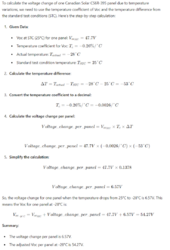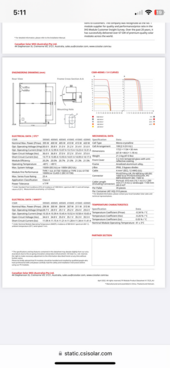I am a virtual newbie when it comes to solar though I have built a teardrop trailer with all victron components that works very well thanks to the Will Prowse videos. I have designed and purchased the following for my off grid barn. EG4 6000xp scc/inverter, EG4 LL-S 48v 100ah battery x 2, and 10
Canadian Solar CS6R395 panels. I am in NW Arkansas and concerned about my understanding of the solar panel output in winter. By my calculations these panels have a Voc temp coefficient of -0.26°C which gives me a 10s string Voc of 504.348 Vdc at -28°C (-18.4°F) which is clearly over the MPPT spec. At -25°C (-13°F) I’m ok at 475.8 Vdc but just barely. With climate change a fact, imho, I’m concerned that even at -25°C I’m risking the health and welfare of the 6000xp.So the questions: 1. Are my numbers shown reasonable? 2. Is there a low temp cutoff in the 6000xp that I can set to turn off charging at say 1°C? To be honest I’ve read the 6000xp manual but not the LL-S battery manual which I’m sure can shut itself down at a specified temp. 3. Would a temp monitoring circuit with a suitable DC rated relay be prudent to cut off the PV string at 1°C so there is zero chance of charging below freezing? It would be an overkill processor wise but a Raspberry Pi could easily do the temp sensing and relay control. 4. Anyone have a better approach to protecting the 6000XP from over-voltage AND protecting the LiFePO4 batteries from charging below freezing without cutting out any panels? Thank you for the wealth of information found in this forum. And apologies for cross posting but no one replied where it was and I really could use some help.






